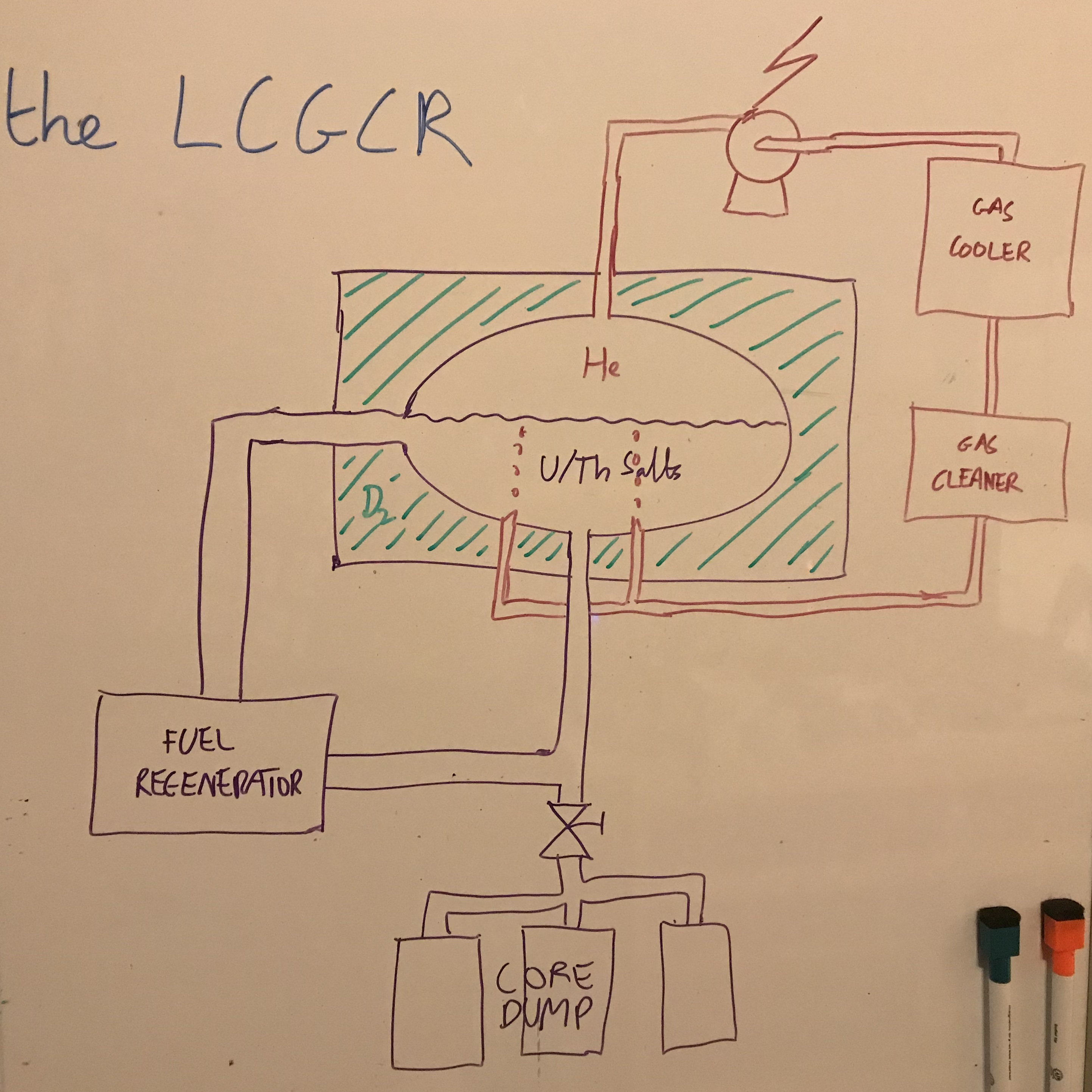So I’ve been playing around a bit with nuclear reactor design, as one does. Thinking about the gap in the portfolio between the high-performance and high-unfriendliness molten-salt designs mentioned for use in power armor, and the low-power pebble-bed designs used for distributed medium-power applications, and wondering what exactly the sort of fission reactors the Empire used back in the old pre-fusion days for civil power.
Herein is the not-yet-canonical result, and I invite physicists, nuclear engineers, and so forth, to tell me all the places I’ve gone horribly wrong. Behold the LCGCR: the liquid-core gas-cooled reactor!
Basically, it’s a liquid fuel design (I’m considering here solutions of uranium and/or thorium salts, rather than molten salts; probably in water, unless there’s a more convenient solvent available.) to take advantage of their self-adjusting reactor dynamics. The formulation of the fuel solution is such that it only achieves criticality when inside the calandria containing the deuterium oxide (heavy water – ignore the D2 on the diagram, that’s a writo) moderator; elsewhere in the fuel loop it doesn’t have that. (The details of the calandria – such as the precise arrangement of moderator around fuel – and the control systems for tuning the reaction are omitted in this diagram.)

The fuel loop itself is how we keep the reactor running continuously and maximize fuel use. The liquid fuel continuously circulates through the reactor and the fuel regenerator (heat exchangers omitted for clarity). The fuel regenerator is where we filter neutron poisons and stable fission products that won’t burn any more out of the fuel, and top it up with fresh salts as required, ensuring that we can use all of the U/Th we put in and all their useful decay products too.
(As a safety feature, we have the core dump valve located right at the bottom of the fuel loop. In the event of something going horribly wrong with the plan, opening this valve empties the whole fuel loop into a safe-storage system split across multiple tanks, set up so that none of them can possibly achieve criticality and all can handle the decay heat of however much of the core they get.)
We get the heat out for use by bubbling an inert gas (helium seems to be a good choice, given its low neutron cross-section and susceptibility to neutron activation, meaning the primary coolant loop is probably clean enough to run the turbines off directly) through the salt solution in the calandria. After running the turbines, we feed it through a gas cooler and a gas cleaner, which latter removes neutron poisons such as xenon, and other gaseous products of the nuclear reaction, before returning to the reactor.
This is of course a very brief sketch of a design which I haven’t spent all that much time thinking about, but it seems to me to be roughly plausible and to have a few interesting advantages. Your thoughts, sirs?

Long time lurker here. I have two concerns. The first is that the high-density uranium might try to settle out either in the reactor or elsewhere in the supply chain forming a prompt criticality. I know that a Japanese radiation worker working with dissolved uranium accidentally poured it into a jug that was shaped wrong and later died of the 600 rem acute dose he took. Meltdowns are chronic environmental hazards but can be worked with. A prompt criticality will kill you before you know something is wrong. The other issue I have is the risk of thermal dissociation of your water during an overheat scenario. dissociation will make corrosive oxygen damaging the reactor/causing holes and explosive hydrogen to blow up the reactor and throw intensely radioactive steam into the air.
I should be clear that the reason for this criticism is that molten salt is less susceptible to those particular problems.
Thanks for your comments!
On the former, in the reactor at least, I had preventing that in mind as a convenient side-effect of the gas cooling; the turbulent flow induced by the helium being blown through – apart from improving thermal transfer – helping to keep the fuel agitated to prevent density-related hot spots or prompt criticalities from forming.
On the latter, on reflection, I’m inclined to agree with you. Fortunately, it shouldn’t be too much trouble to adapt this to be a molten-salt LCGCR assuming the fuel regenerator can be made to function with a carrier-salt solvent and at temperatures sufficient to keep the salt molten.
Chem. engineering alumnus speaking here: gases make a very poor heat carrier compared to liquids, especially given the quantity of thermal energy you want to move out of the reactor core to drive your generators. You’ve already got a liquid loop in your design; I’d recommend that you slap a heat exchanger on there to move your thermal energy to your generator’s working fluid loop (and sparing you the worry about radioactive contamination outside the fuel system).
Also, one of the main reasons molten salts are considered as a thermal transfer medium in reactor designs is that they can take the high core temperatures as liquids without needing the kinds of pressures that are needed to keep water from (rather enthusiastically) flashing to steam in the last place you want it to.
What’s the Eldrae radiation safety limit structure look like. I’m guessing that they’ve got more biological tolerance than humans due to environment and immortality, also pretty sure that they didn’t get sidetracked into believing the linear-no-threshold model. Much of our reactor design (especially in the later designs) is predicated on minimizing radiation exposure at all costs. If you can tolerate coal-plant-in-Denver levels of radiation exposure without batting an eye it makes much of the containment design easier.